Perciò ogni stagione sarà dolce per te,
sia che l’estate rivesta tutta la terra
di verde, o che il pettirosso si posi e canti
tra i fiocchi di neve sul ramo spoglio
del melo molle di muschio, mentre il vicino tetto di paglia
pel disgelo fumiga al sole, sia che sgrondino gocciole
udite soltanto nella tregua della bufera,
o che il segreto ministero del gelo
lo sospenda in silenti ghiaccioli,
quieti scintillando alla quieta luna.
Frost at Midnight, Samuel Taylor Coleridge, 1798
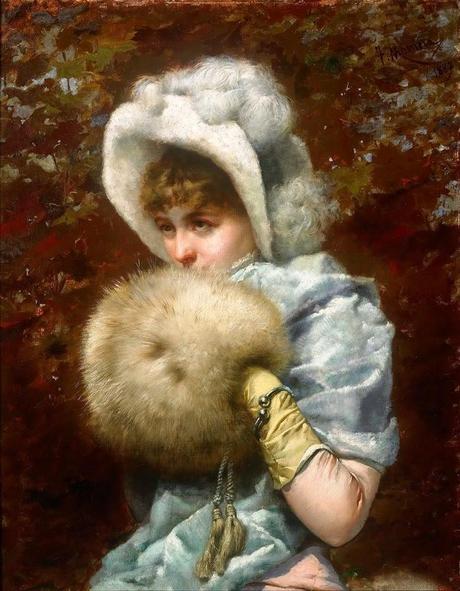
Winter, Francesc Masriera, 1882
Di poesia in poesia, sempre a sfondo invernale, vorrei parlarvi oggi della moda tardo vittoriana (1870 - 1900).

December 1870
Gli inverni non meno rigidi dei nostri e le abitazioni sicuramente meno confortevolmente riscaldate imponevano, seppure sul finire del XIX secolo, l'utilizzo di tessuti pesanti anche per gli abiti 'da casa', tessuti quali il velluto, il panno, il broccato e le vigogne di lana erano quelli prediletti, sempre più spesso arricchiti con pieghe, arricciature di crescente imponenza, che non erano create per vezzo, quanto piuttosto per dare spessore, peso all'abito e perciò produrre il calore necessario a riscaldare il corpo di chi lo indossava; va da sé che il metraggio necessario per confezionare un abito cresceva con la ricchezza della sua foggia perciò alle ladies più abbienti era permesso di soffrire meno il freddo, ahimè !
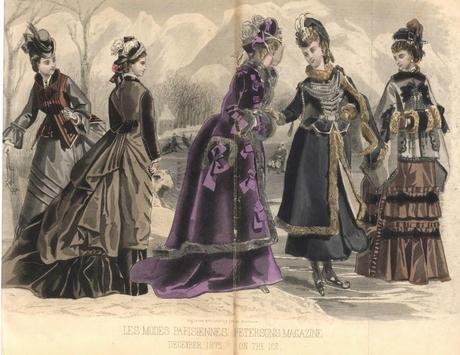
December 1875
Gli abiti da passeggio erano spesso corredati da inserti in pelliccia, abbelliti ed ingentiliti da mantelle più o meno lunghe e pesanti a seconda delle circostanze; indispensabili erano i manicotti, atti a proteggere le mani ed i polsi dal gelo.
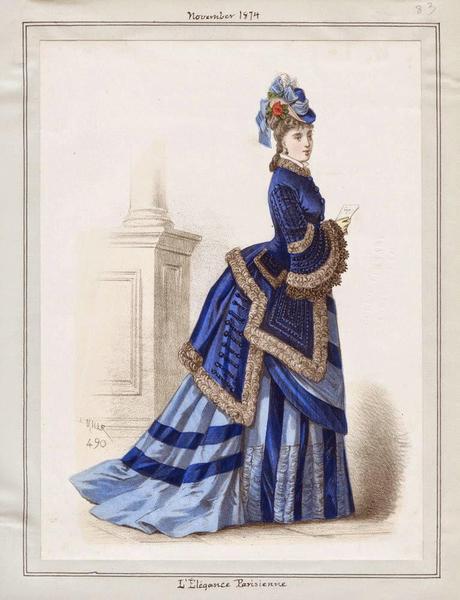
November 1874
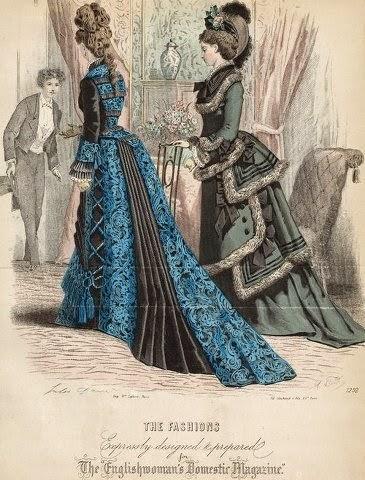
February 1876
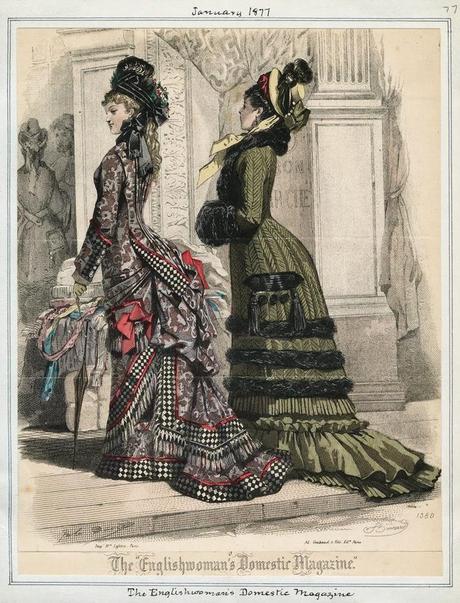
January 1877
Con l'approssimarsi degli anni ottanta le gonne rinunciano alla ricca quantità di tessuto che componeva le ampie sottovesti, preziose complici, soprattutto in inverno, nell'attenuare l'infiltrarsi del freddo,
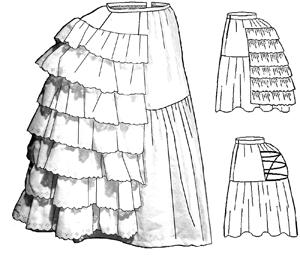
e del bustle
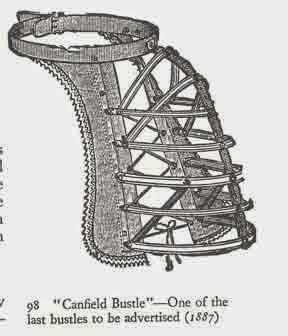
ovvero l'armatura a stecche, talvolta imbottita, collocata posteriormente sotto la vita, ad enfatizzare le terga, per divenire sempre più avvolgenti e per sottolineare con sempre maggior intenzione ed enfasi le forme originali del corpo femminile.
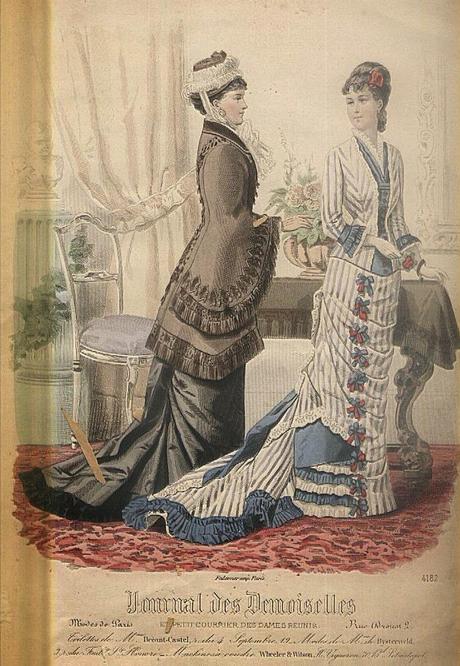
Winter 1878
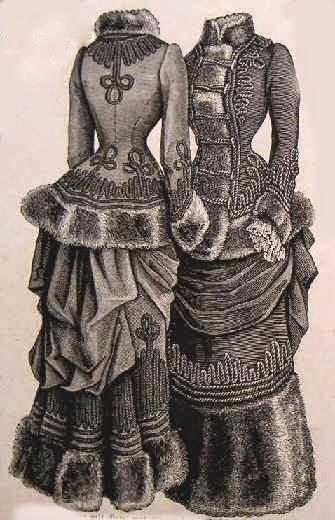
Early 1880's
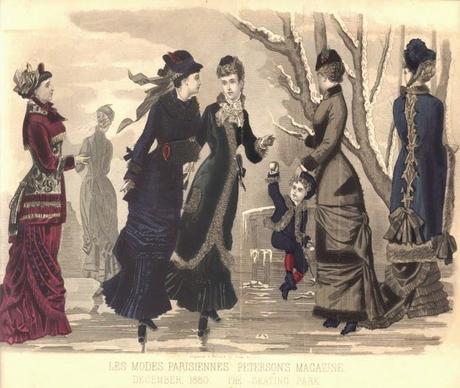
December 1880
Durante questo ventennio sono pochi i mutamenti che subiscono i copricapo femminili che, sempre continuano a mantenersi di dimensioni piuttosto contenute conservando la precipua funzione di rifinire le elaboratissime acconciature, senza rinunciare a ricchi passamaneria, nastri, fiori di tessuto, fiocchi e piume.
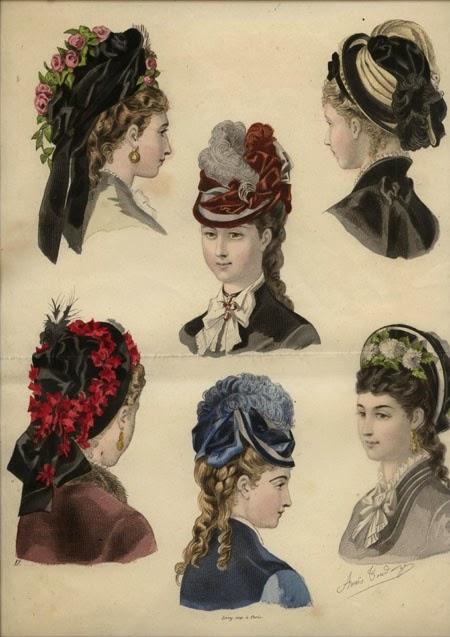
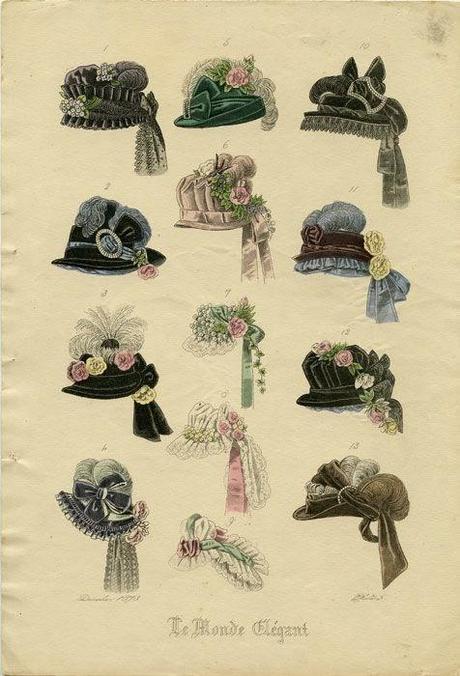
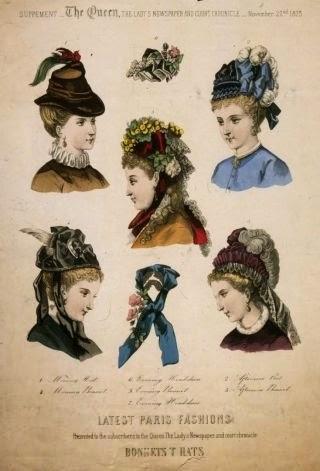
Un brusco mutamento lo subisce la moda degli anni novanta: le gonne vengono fatte a più teli, generalmente quattro o sei per allargarsi a corolla verso il fondo e le maniche acquistano sempre più importanza ... nascono le così dette maniche a sbuffo chiamate anche gigot o maniche a zampa di montone, composte di quattro teli (la maggior parte delle maniche oggi sono tagliate da un unico pezzo), che venivano imbottite dal gomito fino all'altezza della spalla per mantenerne la forma così importante verso l'alto.
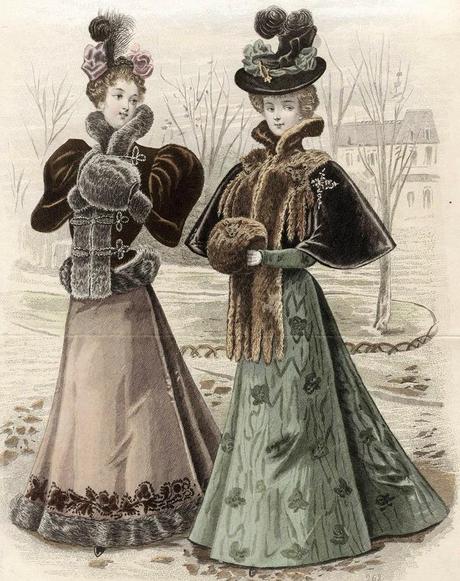
Winter 1893
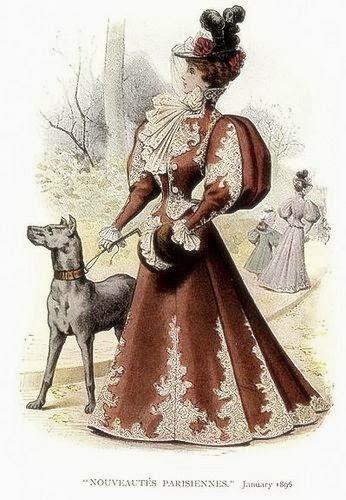
January 1895
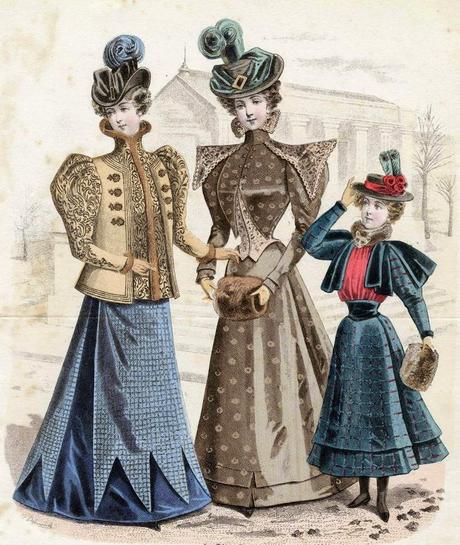
Winter 1896
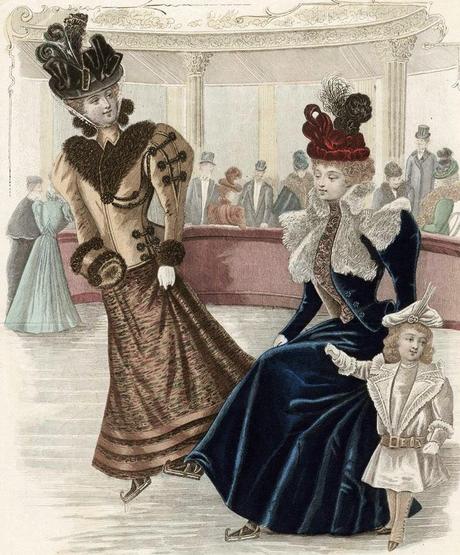
Winter 1896 Skating Fashion
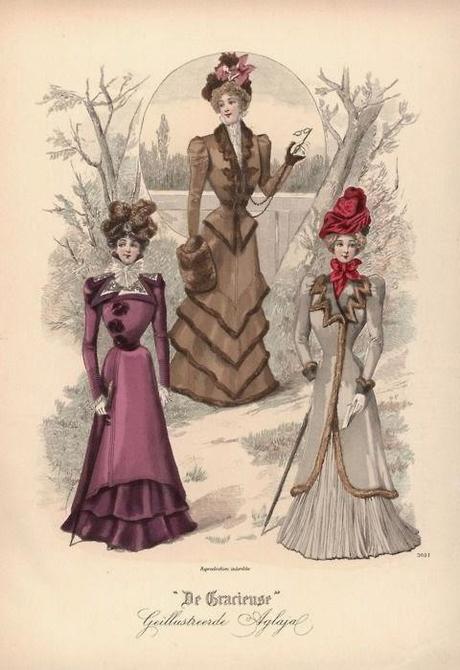
Winter 1899 Walking Dresses
E come avrete sicuramente notato i cappelli acquistano in ampiezza per divenire veri e propri accessori separati dall'acconciatura che perde in imponenza e volume per farsi piuttosto larga ed ondulata piuttosto che intrecciata.
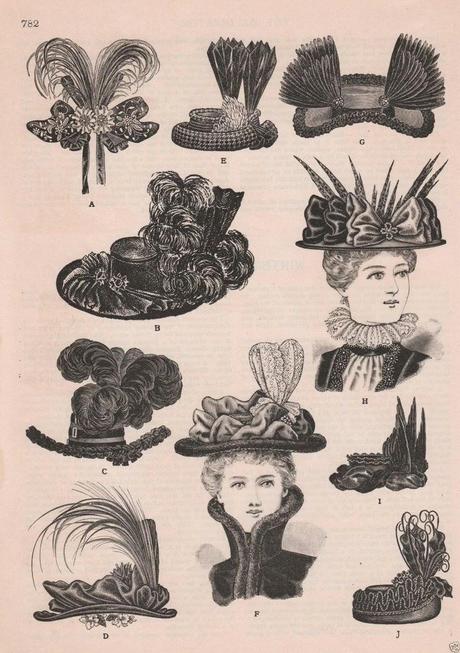
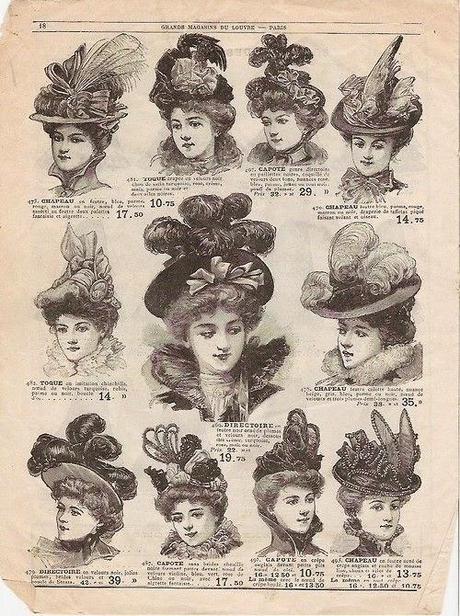
Ed eccoci così giunti in fondo al nostro excursus con uno degli ultimi modelli vittoriani, risalente all'anno 1900,
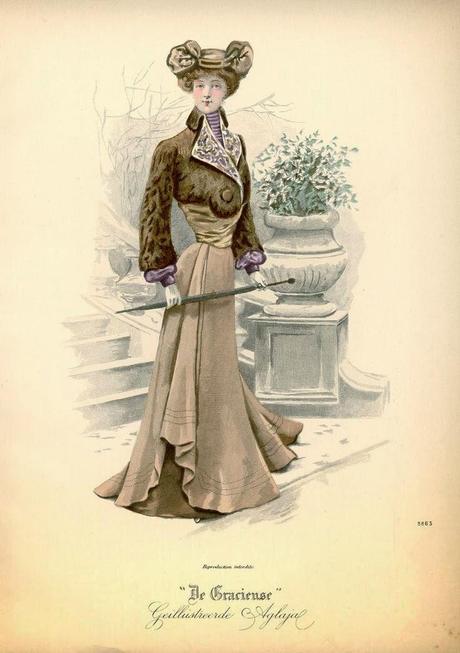
che vi mostra come le gonne, fatte con tessuti sempre più leggeri che più si prestano al movimento, dal cachemire alla flanella, diventano insieme con l'esaltazione del petto, il punto di forza di questa nuova silhouette ... dicevo che questo è certamente uno dei modelli conclusivi di un'epoca da che con il 1901 si eclissa, con la dipartita della Regina Vittoria il 22 gennaio, quella vittoriana ed inizia quella edoardiana, all'insegna delle Gibson Girls.
Vi auguro con tutto il mio affetto di trascorrere un sereno inverno, confortati dal calore delle vostre dimore e dall'affetto dei vostri cari, che il vostro focolare domestico scaldi i vostri cuori e vi doni la quiete interiore che questa stagione, di generale torpore e riposo della Natura, suggerisce anche al nostro animo.
A presto ♥
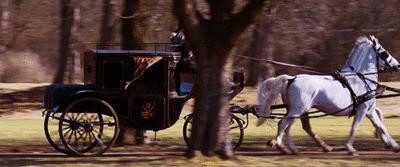

Bibliografia:
Stella Blum, Victorian Fashions and Costumes from Harper's Bazar, 1867-1898, Dover Publications, 1974
Alison Gernsheim, Victorian and Edwardian Fashion: A Photographic Survey (Dover Fashion and Costumes), Dover Publications, 1982
Kristina Harris, Victorian Fashion in America: 264 Vintage Photographs (Dover Fashion and Costumes), Dover Publications, 2002
Lucy Johnston, Nineteenth Century Fashion in Detail, Victoria & Albert Museum, 2009
Note:
Tutte le stampe di moda qui pubblicate sono state attinte dalle seguenti riviste femminili del tempo:
THE MILLINER AND DRESSMAKER
LES MODES PARISEIENNES: PETERSON'S MAGAZINE
L'Elégance Parisienne
The Englishwoman's Domestic Magazine
Journal des Demoiselle
Le Monde Elégant
The Queen
NOVEAUTES PARISIENNES
De Gracieuse

Therefore all seasons shall be sweet to thee,
Whether the summer clothe the general earth
With greenness, or the redbreast sit and sing
Betwixt the tufts of snow on the bare branch
Of mossy apple-tree, while the nigh thatch
Smokes in the sun-thaw; whether the eave-drops fall
Heard only in the trances of the blast,
Or if the secret ministry of frost
Shall hang them up in silent icicles,
Quietly shining to the quiet Moon.
Frost at Midnight, Samuel Taylor Coleridge, 1798
- picture 1 - Winter, Francesc Masriera, 1882
From poetry to poetry, always in a winter background, I want to talk to you today of late Victorian fashion (1870-1900).
- picture 2 - December 1870
Winters no less rigid than nowadays and houses certainly less comfortably heated than ours imposed, still in the late XIXth century, the use of heavy fabrics for the clothes even for staying at home, fabrics such as velvet, cloth, brocade and vicuña wool were those beloved, increasingly enriched with folds, curls of grandeur, that weren't made by boast, but rather to give thickness, weight to the dress and therefore to produce the heat needed to warm up the body of the lady who wore it; it goes without saying that the lenght needed to sew a dress grew with the richness of its shape so to more wealthy ladies was allowed to suffer less cold, alas!
- picture 3 - December 1875
The walking dresses were often accompanied by fur inserts, embellished and refined with capes more or less long and more or less heavy depending on the circumstances; they were indispensable muffs, designed to protect hands and wrists from frost.
- picture 4 - November 1874
- picture 5 - February 1876
- picture 6 - January 1877
With the approach of the 80's skirts give up the rich amount of fabric that composed the wide petticoats, precious accomplices, especially in winter, in attenuating the infiltration of cold,
- picture 7
and the bustle
- picture 8
an armor made of slatted sometimes padded, placed posteriorly below the waist, to emphasize their backs, to become more and more enveloping and to undelnine more and more, with intention and emphasis, the original forms of the feminine body.
- picture 9 - Winter 1878
- picture 10 - Early 1880's
- picture 11 - December 1880
During these twenty years they were few the changes suffered by lady's hats, as they always continue to remain rather small in size while preserving the main function to finish the elaborate hairstyles, without sacrificing rich trimmings, ribbons, fabric flowers, bows and feathers.
- picture 12
- picture 13
- picture 14
An abrupt change undergoes the fashion of the 90's: the skirts are made by four or six gore, to widen flared towards the bottom and the sleeves are becoming increasingly important ... they were born the over-sized puffy sleeves also called gigots, or leg-o-mutton sleeves. They were often made from four separate pieces of fabric (most sleeves nowadays are cut from one piece) which were padded from the elbow up to the shoulder to keep their shape so important upward.
- picture 15 - Winter 1893
- picture 16 - January 1895
- picture 17 - Winter 1896
- picture 18 - Winter 1896 Skating Fashion
- picture 19 - Winter 1899 Walking Dresses
And as you may have noticed hats earns amplitude to become genuine accessories completely separate from the hairstyle who loses in grandeur and volume to be rather large and undulating instead of braided.
- picture 20
- picture 21
And here we have thus arrived at the end of our excursion with one of the last Victorian models, dating 1900,
- picture 22
showing you how the skirts, made by ever lighter fabrics which are best suited to the movement, from cashmere to flannel, become, together with the exaltation of the chest, the strong point of this new silhouette ... I said that this is certainly one of the models which were conclusive of an era that will be eclipsed by 1901, with the departure of Queen Victoria on January 22nd, the Victorian era, when the Edwardian one is going to begin in the name of the Gibson Girls.
I wish you with all my love to spend a relaxing winter, comforted by the warmth of your homes and by the affection of your loved ones, that may your hearth warm your hearts and give you the inner peace that this season, of general torpor and rest of Nature, also suggests to our mind.
See you soon ♥
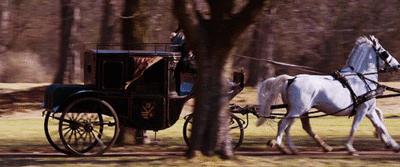

Bibliography:
Stella Blum, Victorian Fashions and Costumes from Harper's Bazar, 1867-1898, Dover Publications, 1974
Alison Gernsheim, Victorian and Edwardian Fashion: A Photographic Survey (Dover Fashion and Costumes), Dover Publications, 1982
Kristina Harris, Victorian Fashion in America: 264 Vintage Photographs (Dover Fashion and Costumes), Dover Publications, 2002
Lucy Johnston, Nineteenth Century Fashion in Detail, Victoria & Albert Museum, 2009
Notes:
All the fashion plates published here have been drawn by the following women's magazines of the time:
THE MILLINER AND DRESSMAKER
LES MODES PARISEIENNES: PETERSON'S MAGAZINE
L'Elégance Parisienne
The Englishwoman's Domestic Magazine
Journal des Demoiselle
Le Monde Elégant
The Queen
NOVEAUTES PARISIENNES
De Gracieuse
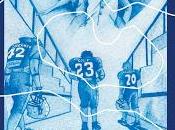




![[Rubrica: Italian Writers Wanted #11]](https://m21.paperblog.com/i/289/2894652/rubrica-italian-writers-wanted-11-L-NfHdN5-175x130.png)

